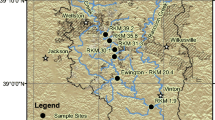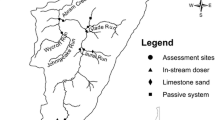Abstract
The East Branch of Raccoon Creek, Ohio is highly impacted by pre-regulation coal mining and contains 10 steel slag leach beds that passively treat the low pH, and the Fe and Al-rich waters. Water chemistry, sediment chemistry, aquatic macroinvertebrate richness and diversity, habitat quality, and stream gradient were examined along the mainstem and a headwater tributary where multiple treatment systems are located. The stream gradient showed no significant relationship with sediment quality. Higher flows increased instream concentrations of Fe and the portion of suspended Fe in the water column. Macroinvertebrate richness and diversity varied from good to very poor and were negatively correlated with sediment Cu, Fe, Mn, and other water quality parameters such as specific conductivity and total dissolved solids, but were positively correlated with pH.
Resumen
La Rama Este de Raccoon Creek, Ohio, está muy afectada por la minería de carbón pre-regulada y contiene 10 lechos de lixiviación de escoria de acero que tratan de forma pasiva los bajos valores de pH y las aguas ricas en Fe y Al. Se examinaron la química del agua, la química de los sedimentos, la riqueza y diversidad de macroinvertebrados acuáticos, la calidad del hábitat y el gradiente de la corriente a lo largo del torrente principal y de un afluente de aguas de cabeza donde se ubican múltiples sistemas de tratamiento. El gradiente de la corriente no mostró una relación significativa con la calidad del sedimento. Los flujos más altos aumentaron las concentraciones de Fe en flujo continuo y la porción de Fe suspendido en la columna de agua. La riqueza y diversidad de macroinvertebrados varió de buena a muy pobre y se correlacionó negativamente con Cu, Fe, Mn del sedimento y otros parámetros de calidad del agua tales como la conductividad específica y los sólidos disueltos totales, pero se correlacionaron positivamente con el pH.
Zusammenfassung
Der östliche Nebenarm des Raccoon Creek, Ohio, ist stark durch den Kohlebergbau beeinflusst. Es wurden 10 Reinigungsstufen zur passiven Wasserbehandlung mit Stahlschlacke installiert, um den niedrigen pH-Wert anzuheben und das Fe- und Al-reiche Wasser zu behandeln. Entlang des Hauptstromes und im Oberlauf eines Nebenarms wurden die Wasserchemie, die Sedimentbeschaffenheit, die Menge und Diversität von aquatischen Makroinvertebraten, die Lebensraumqualität und der Strömungsgradient untersucht. Der Strömungsgradient zeigte keine signifikante Beziehung zur Sedimentbeschaffenheit. Höhere Durchflüsse führten zu einem Anstieg der Eisenkonzentration im Wasser und des Anteils von ungelöstem Eisen in der Wassersäule. Die Vielfalt und Diversität der Makroinvertebraten variierten von gut bis sehr schlecht und korrelierten negativ mit der Konzentration von Cu, Fe und Mn im Sediment sowie anderen Wasserparametern, wie die elektrische Leitfähigkeit und die gesamten gelösten Feststoffen. Eine positive Korrelation bestand jedoch zum pH-Wert.
抽象
俄亥俄州浣熊溪(Raccoon Creak)的东部支流受早期非规范煤炭开采的强烈影响后, 用10个钢渣浸床处理低pH值、富铁和富铝的被污染溪水。干流和源头支流布置了多个水处理系统。 检测了沿干流和源头支流的水化学、沉积物化学、水生大型无脊椎动物丰富性和多样性、生境质量和河流坡度。水力坡度与沉积物质量无显著相关。雨季高位水流使河道内铁浓度增大和溪流水体悬浮态铁比例提高。大型无脊椎动物的丰富性和多样性从好到差变化不一; 它与铜、铁、锰的沉积和其它水质参数(如比电导率和总溶解固体)负相关而与pH值正相关。







Similar content being viewed by others
References
Abraitis P, Pattrick R, Vaughan D (2004) Variations in the compositional, textural and electrical properties of natural pyrite: a review. Int J Min Process 74(1):41–59
Asta MP, Cama J, Martínez M, Giménez J (2009) Arsenic removal by goethite and jarosite in acidic conditions and its environmental implications. J Hazard Mater 171(1):965–972
Barbour MT, Gerritsen J, Snyder B, Stribling J (1999) Rapid bioassessment protocols for use in streams and wadeable rivers. USEPA, Washington DC
Bednar A, Garbarino J, Ranville J, Wildeman T (2005) Effects of iron on arsenic speciation and redox chemistry in acid mine water. J Geochem Explor 85(2):55–62
Beltman DJ, Clements WH, Lipton J, Cacela D (1999) Benthic invertebrate metals exposure, accumulation, and community-level effects downstream from a hard-rock mine site. Environ Toxicol Chem 18(2):299–307
Bott TL, Jackson JK, McTammany ME, Newbold JD, Rier ST, SweeneyBW BJ (2012) Abandoned coal mine drainage and its remediation: impacts on stream ecosystem structure and function. Ecol Appl 22(8):2144–2163
Bowman J, Sullivan N, Johnson K (2017) 2016 Stream health report: an evaluation of water quality, biology, and acid mine drainage reclamation in five watersheds: Raccoon Creek, Monday Creek, Sunday Creek, Huff Run, and Leading Creek. www.watersheddata.com. Accessed 13 Aug 2018
Buchanan TJ, Somers WP (1969) Discharge measurements at gaging stations: US Geological survey techniques of water-resources investigations. Book 3:65
Burton GA (1991) Assessing the toxicity of freshwater sediments. Environ Toxicol Chem 10(12):1585–1627
Chapman PM, Wang F, Janssen C, Persoone G, Allen HE (1998) Ecotoxicology of metals in aquatic sediments: binding and release, bioavailability, risk assessment, and remediation. Can J Fish Aquat Sci 55(10):2221–2243
Cravotta C III, Bilger M (2001) Water-quality trends for a stream draining the Southern Anthracite Field, Pennsylvania. Geochem Explor Environ Anal 1(1):33–50
DeNicola DM, Stapleton MG (2002) Impacts of acid mine drainage on benthic communities in streams: the relative roles of substratum vs. aqueous effects. Environ Poll 119(3):303–315
Dsa JV, Johnson KS, Lopez D, Kanuckel C, TumLinson J (2008) Residual toxicity of acid mine drainage-contaminated sediment to stream macroinvertebrates: relative contribution of acidity vs. metals. Water Air Soil Poll 194(1–4):185–197
Ewais TA, Grant A, Fattah AA (2000) The role of surface coatings on sediments in sediment: water partitioning of trace elements and radionuclides. J Environ Radioact 49(1):55–64
Fitzpatrick FA, Waite IR, D’Arconte PJ, Meador MR, Maupin MA, Gurtz ME (1998) Revised methods for characterizing stream habitat in the National Water-Quality Assessment Program. US Department of the Interior, US Geological Survey, New York
Gensemer RW, Playle RC (1999) The bioavailability and toxicity of aluminum in aquatic environments. Crit Rev Environ Sci Technol 29(4):315–450
Hindall S (1984) Effects of surface coal-mine reclamation on stream quality in a small watershed near Nelsonville, Southeastern Ohio. Water-Resources Investigations Report, Ohio
Hogsden KL, Harding JS (2011) Consequences of acid mine drainage for the structure and function of benthic stream communities: a review. Freshw Sci 31(1):108–120
Hudson-Edwards K (2003) Sources, mineralogy, chemistry and fate of heavy metal-bearing particles in mining-affected river systems. Mineral Magn 67(2):205–217
IBM SPSS Statistics for Windows (2012) Version 21.0. IBM Corp, Armonk, NY
Johnson KS, Thompson PC, Gromen L, Bowman J (2014) Use of leaf litter breakdown and macroinvertebrates to evaluate gradient of recovery in an acid mine impacted stream remediated with an active alkaline doser. Environ Monit Assess 186(7):4111–4127
Kemble NE, Brumbaugh WG, Brunson EL, Dwyer FJ, Ingersoll CG, Monda DP, Woodward DF (1994) Toxicity of metal-contaminated sediments from the upper clark fork river, montana, to aquatic invertebrates and fish in laboratory exposures. Environ Toxicol Chem 13(12):1985–1997
Kennedy VC (1971) Silica variation in stream water with time and discharge. Nonequilib Syst Nat Water Chem 106:94–130
Kenney MA, Sutton-Grier AE, Smith RF, Gresens SE (2009) Benthic macroinvertebrates as indicators of water quality: the intersection of science and policy. Terr Arthropod Rev 2(2):99–128
Kinney CJ (2006) A comparison of two methods of bioassessment in streams. Thesis Ohio University https://etd.ohiolink.edu/!etd.send_file?accession=ohiou1149170886&disposition=inline. Accessed 1 Dec 2013
Kruse NA, Mackey AL, Bowman JR, Brewster K, Riefler RG (2012) Alkalinity production as an indicator of failure in steel slag leach beds treating acid mine drainage. Environ Earth Sci 67(5):1389–1395
Kruse NA, DeRose L, Korenowsky R, Bowman JR, Lopez D, Johnson K, Rankin E (2013) The role of remediation, natural alkalinity sources and physical stream parameters in stream recovery. J Environ Manag 128:1000–1011
Kruskal WH, Wallis WA (1952) Use of ranks in one-criterion variance analysis. J Am Stat Assoc 47(260):583–621
Lasier P, Winger P, Bogenrieder K (2000) Toxicity of manganese to Ceriodaphnia dubia and Hyalella azteca. Arch Environ Con Tox 38(3):298–304
Laverty B (2005) Assessment of Acid Mine Drainage Sources in the East Branch-Raccoon Creek Watershed. Vinton Soil and Water Conservation District, McArthur, Ohio
Lee G, Bigham JM, Faure G (2002) Removal of trace metals by coprecipitation with Fe, Al and Mn from natural waters contaminated with acid mine drainage in the Ducktown Mining District, Tennessee. Appl Geochem 17(5):569–581
Lynch SF, Batty LC, Byrne P (2014) Environmental risk of metal mining contaminated river bank sediment at redox-transitional zones. Miner 4(1):52–73
MacCausland A, McTammany M (2007) The impact of episodic coal mine drainage pollution on benthic macroinvertebrates in streams in the Anthracite region of Pennsylvania. Environ Pollut 149(2):216–226
McClurg SE, Petty JT, Mazik PM, Clayton JL (2007) Stream ecosystem response to limestone treatment in acid impacted watersheds of the Allegheny Plateau. Ecol Appl 17(4):1087–1104
Microsoft (2010) Microsoft excel. Redmond, Washington
Niyogi DK, Lewis WM Jr, McKnight DM (2002) Effects of stress from mine drainage on diversity, biomass, and function of primary producers in mountain streams. Ecosystems 5(6):554–567
Nordstrom DK (2009) Acid rock drainage and climate change. J Geochem Explor 100(2):97–104
ODNR (Ohio Dept of Natural Resources) (2011) Detailed specifications east branch raccoon creek phase III—Winifred SSLB. Ohio Department of Natural Resources, Ohio
Ohio Environmental Protection Agency (2001) Sediment Sampling Guide and Methodologies. 2nd edn. http://www.epa.ohio.gov/portals/35/guidance/sedman2001.pdf. Accessed 15 Feb 2015
Ohio Environmental Protection Agency (2006) Methods for assessing habitat in flowing waters: Using the Qualitative Habitat Evaluation Index (QHEI)
Persaud D, Jaagumagi R, Hayton A (1993) Guidelines for the protection and management of aquatic sediment quality in Ontario: Report. Water Resources Branch, Ontario Ministry of the Environment, Ontario
Rankin ET (1989) The qualitative habitat evaluation index [QHEI]: Rationale, methods, and application. Ohio Environmental Protection Agency
RStudio (2015) (Version 3.1.0). Boston, MA: RStudio. Retrieved from http://www.rstudio.org/. Accessed 15 Feb 2015
Sheoran A, Sheoran V (2006) Heavy metal removal mechanism of acid mine drainage in wetlands: a critical review. Miner Eng 19(2):105–116
Simmons J, Ziemkiewicz P, Black DC (2002) Use of steel slag leach beds for the treatment of acid mine drainage. Mine Water Environ 21(2):91–99
Singh AK, Hasnain S, Banerjee D (1999) Grain size and geochemical partitioning of heavy metals in sediments of the Damodar River–a tributary of the lower Ganga, India. Environ Geol 39(1):90–98
Smith EP, Voshell JR (1997) Studies of benthic macroinvertebrates and fish in streams within EPA Region 3 for development of biological indicators of ecological condition. Virginia Polytechnic Institute and State University
Tiwary R (2001) Environmental impact of coal mining on water regime and its management. Water Air Soil Poll 132(1–2):185–199
United States Environmental Protection Agency (1994) Sediment Sampling. http://www.dem.ri.gov/pubs/sops/wmsr2016.pdf. Accessed 15 Feb 2015
United States Environmental Protection Agency (1996) Method 3050B: Acid Digestion of Sediments, Sludges, and Soils, Revision 2. https://www.epa.gov/sites/production/files/2015-06/documents/epa-3050b.pdf. Accessed 15 Feb 2015
Yoder CO, Rankin ET (1996) Assessing the condition and status of aquatic life designated uses in urban and suburban watersheds. Effects of Watershed Development and Management on Aquatic Ecosystems. American Society of Civil Engineers, New York, 201–227
Younger PL, Banwart SA, Hedin RS (2002) Mine water: hydrology, pollution, remediation, vol 5. Springer, New York
Acknowledgements
Special thanks go to the Raccoon Creek Partnership staff members who assisted with field work. This work was funded in part by a gift from the American Electric Power Foundation.
Author information
Authors and Affiliations
Corresponding author
Rights and permissions
About this article
Cite this article
Kruse, N., Hawkins, C., López, D.L. et al. Recovery of an Acid Mine Drainage-Impacted Stream Treated by Steel Slag Leach Beds. Mine Water Environ 38, 718–734 (2019). https://doi.org/10.1007/s10230-019-00636-y
Received:
Accepted:
Published:
Issue Date:
DOI: https://doi.org/10.1007/s10230-019-00636-y




